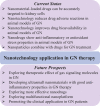Application of nanotechnology in the treatment of glomerulonephritis: current status and future perspectives
- PMID: 38169389
- PMCID: PMC10763010
- DOI: 10.1186/s12951-023-02257-8
Application of nanotechnology in the treatment of glomerulonephritis: current status and future perspectives
Abstract
Glomerulonephritis (GN) is the most common cause of end-stage renal failure worldwide; in most cases, it cannot be cured and can only delay the progression of the disease. At present, the main treatment methods include symptomatic therapy, immunosuppressive therapy, and renal replacement therapy. However, effective treatment of GN is hindered by issues such as steroid resistance, serious side effects, low bioavailability, and lack of precise targeting. With the widespread application of nanoparticles in medical treatment, novel methods have emerged for the treatment of kidney diseases. Targeted transportation of drugs, nucleic acids, and other substances to kidney tissues and even kidney cells through nanodrug delivery systems can reduce the systemic effects and adverse reactions of drugs and improve treatment effectiveness. The high specificity of nanoparticles enables them to bind to ion channels and block or enhance channel gating, thus improving inflammation. This review briefly introduces the characteristics of GN, describes the treatment status of GN, systematically summarizes the research achievements of nanoparticles in the treatment of primary GN, diabetic nephropathy and lupus nephritis, analyzes recent therapeutic developments, and outlines promising research directions, such as gas signaling molecule nanodrug delivery systems and ultrasmall nanoparticles. The current application of nanoparticles in GN is summarized to provide a reference for better treatment of GN in the future.
Keywords: Diabetic nephropathy; Lupus nephritis; Nanocarrier; Nanotechnology; Primary glomerulonephritis; Therapy.
© 2023. The Author(s).
Conflict of interest statement
The authors declare no conflicts of interest.
Figures






Similar articles
-
Clinical outcomes in patients with biopsy-proved diabetic nephropathy compared to isolated lupus or crescentic glomerulonephritis.Diabetes Res Clin Pract. 2019 Feb;148:144-151. doi: 10.1016/j.diabres.2019.01.014. Epub 2019 Jan 11. Diabetes Res Clin Pract. 2019. PMID: 30641169
-
[Instructions and implementations for percutaneous renal biopsy. Guidelines for the therapy of glomerular nephropaties].G Ital Nefrol. 2003 Sep-Oct;20 Suppl 24:S3-47. G Ital Nefrol. 2003. PMID: 14666502 Review. Italian.
-
Treatment of lupus nephritis and primary glomerulonephritis with enteric-coated mycophenolate sodium.Clin Nephrol. 2008 Feb;69(2):90-101. doi: 10.5414/cnp69090. Clin Nephrol. 2008. PMID: 18218302
-
Immunohistologic analysis of renal CD40 and CD40L expression in lupus nephritis and other glomerulonephritides.Arthritis Rheum. 1997 Jan;40(1):124-34. doi: 10.1002/art.1780400117. Arthritis Rheum. 1997. PMID: 9008608
-
Targeting the tyrosine kinase signalling pathways for treatment of immune-mediated glomerulonephritis: from bench to bedside and beyond.Nephrol Dial Transplant. 2017 Jan 1;32(suppl_1):i129-i138. doi: 10.1093/ndt/gfw336. Nephrol Dial Transplant. 2017. PMID: 28391340 Free PMC article. Review.
Cited by
-
Targeting the epidermal growth factor receptor (EGFR/ErbB) for the potential treatment of renal pathologies.Front Pharmacol. 2024 Aug 21;15:1394997. doi: 10.3389/fphar.2024.1394997. eCollection 2024. Front Pharmacol. 2024. PMID: 39234105 Free PMC article. Review.
References
Publication types
MeSH terms
Grants and funding
- 52202343, 82172858/National Natural Science Foundation of China
- 2208085QC81, 1208085MH175/Anhui Province Natural Science Foundation
- 2022zhyx-C01/Research Fund of Anhui Institute of Translational Medicine
- 2021xkjT028/Basic and Clinical Cooperative Research and Promotion Program of Anhui Medical University
LinkOut - more resources
Full Text Sources
Medical

